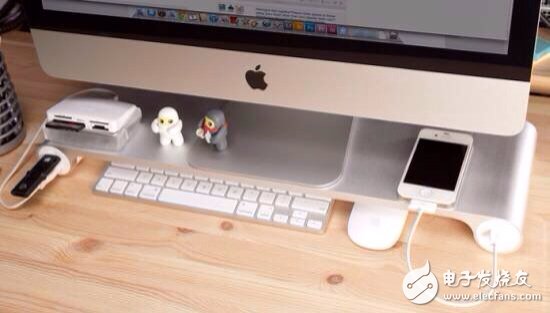The answer is simple, because you may not be full at all.
The USB output voltage of the computer is 5V, which is generally very accurate. The reason why the computer USB is not full is because the USB output current is small, and the last stage of charging requires trickle charging.
Trickle charging is used to compensate for the loss of capacity due to self-discharge after the battery is fully charged. After the battery is fully charged, the capacity lost due to self-discharge is approximately 5% of the nominal capacity.
In theory, trickle charging should be at the level of 1/500 of the charging current, but the computer USB current is only 500mA, the turbulence is too small, so the process is very slow and slow, and often we will pull the line out in advance, such The result is that 5% of the power is gone. Although the power displayed by the mobile phone is still 100% at this time, this is only an algorithmic problem of the power, and it is not really full.
Simple questions are simple and easy to answer. The following is the expansion stage.

The principle of mobile phone charging
At present, almost all mobile phones use lithium batteries. From the point of view of the charging method, the charging mode of the lithium battery is a voltage limiting constant current, which is controlled by the IC chip, specifically, the voltage of the battery to be charged is first detected.
If the voltage is lower than 3V, the phone will be pre-charged first, the charging current is 1/10 of the set current, and when the voltage rises to 3V, the phone will enter the standard charging process.
The standard charging process is: constant current charging with set current. When the battery voltage rises to 4.20V, the mobile phone will be changed to constant voltage charging, and the charging voltage will be 4.20V. At this time, the charging current will gradually decrease, and when the current drops to 1/10 of the set charging current, the charging will be completely completed.
Is it safe to charge the phone with a computer USB?
Many friends have also mentioned this problem, which reflects the problem of leakage of electricity on many mobile phones using computer USB charging.
In fact, this is not the case. The lithium battery of the mobile phone digital product has a protection board, which has the effect of limiting the minimum voltage and limiting the charging current. Moreover, whether the mobile phone is using a charger or a computer USB, it is confusing to go that one. USB cable, what charge, only the difference between the charging current, the other end of the line, as long as there is no problem with the cottage power supply problem. The difference between a regular power supply and a computer USB is only at the speed of charging.
Previously, the media had tested it and used the laptop's USB to charge the mobile phone. Compared with the original charger charging the mobile phone, the charging voltage is slightly higher, about 5V and 4.2V before and after, and the charging current is slightly lower. About 190mA and 220mA, but for desktop USB, the charging voltage is still 5V, and the charging current is increased to 230mA.
Therefore, it can be concluded that the computer is used to charge the mobile phone and charge the mobile phone with the original charger. The difference is only the difference in current and the charging speed, which has little to do with security.
Even if you touch the phone during the charging process, your hand will have a sensation of numbness, but it is just induction electricity. This has a certain relationship with the air humidity and the clothes you wear, similar to static electricity. If you really feel uncomfortable, then the solution is simple, just put the host on the ground.
Aluminum core Solar Cable is a photovoltaic circuit using aluminum as a conductive material. It is widely used in solar power generation systems to transport the electricity generated by solar panels.
Compared with traditional copper solar cable, aluminum solar cable has some obvious advantages, the most important of which is low cost.
1. Low price: Aluminum is a common metal, and its price is cheaper than that of copper. Therefore, the use of aluminum solar cable can reduce the cost of the system and make the entire photovoltaic power generation project more economical.
2. Lightweight: Aluminum has a lower density and is lighter than copper. The aluminum core optical cable can reduce the weight of the cable and facilitate installation and maintenance.
3. Strong corrosion resistance: Aluminum has good corrosion resistance and can maintain a long service life under harsh environmental conditions. This makes the aluminum solar cable more reliable for outdoor use.
4. Excellent conductivity: although the conductivity of copper is higher than that of aluminum, the aluminum solar cable can make up for the shortcomings of the low conductivity of aluminum to a certain extent by optimizing the design and process and ensure the efficiency and stability of power transmission.
It should be noted that there are also some limitations and precautions for aluminum solar cable. Due to the low conductivity of aluminum, the resistance of the aluminum solar cable will be relatively high, so it is necessary to choose the wire diameter and length reasonably when designing and installing to ensure the efficiency of power transmission. In addition, aluminum is prone to electrochemical reactions when it comes into contact with copper, so corresponding measures need to be taken when connecting aluminum solar cable and other components, such as using special connectors or coating protective layers.
In general, aluminum solar cable with its low cost, corrosion resistance, light and other advantages, has been widely used in solar power generation systems, and brings economic and reliability benefits to photovoltaic power generation projects.
Aluminum Solar Cable,Photovoltaic Solar Cable,TUV Aluminum solar cable,Aluminum Energy Cable
Suzhou Yonghao Cable Co.,Ltd. , https://www.yonghaocable.com